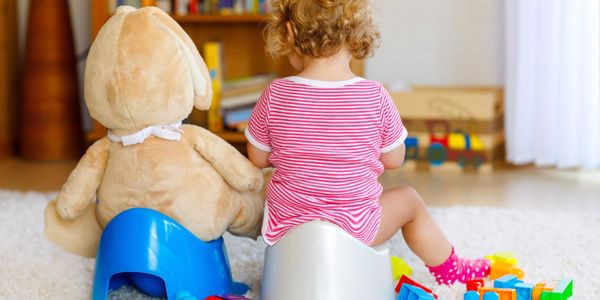Are you a super …. duper … pooper? Well, of course you are! Unfortunately, this does not mean your super, duper toddler will uncomplicatedly jump on the toilet-using bandwagon; and,
“Are you potty training yet?”
People are starting to ask questions.
“You need to put out a potty seat, so they get curious and excited about using it!”
People are telling you what to do.
First of all, don’t panic. When and how to potty train your little one will never be cut-and-dry because one plus one equals two. Secondly, feel free to flush the overwhelming noise down your toilet because this potty-training guide has all the essential information you need to succeed.
This is it, the big milestone. So let’s sing a few potty-training songs from the early 90s – the hit single “Super Duper Pooper,” from Potty Time, being a must – and get our reward charts ready because … it’s time to go.
When To Potty Train
Is timing everything? The truth is there is no one-size-fits-all when it comes to potty training. A healthy child is emotionally and physically ready to begin using a potty between 18 months and 3 years; however, many potty-training experts say there is a “golden window” at about 20 to 30 months.
Your toddler may show signs of readiness earlier than expected, or you may have a three-year-old who still doesn’t care one toot about sitting in full stink, stank, stunk for evermore.
Here are the typical signs your little one is ready:
- shows interest in the potty chair or toilet.
- wants to wear “big-kid” underwear.
- can pull down his or her pants and pull them up again.
- understands and follows simple directions.
- stays dry for up to two hours during the day.
- communicates the need to go to the bathroom with words, facial expressions, or body language.
If your child is displaying each of the above-mentioned signs, they are ready to begin using a potty! Otherwise, consider waiting until you’ve confidently witnessed each and every sign. Another good reason to put off potty training for a few months is if your child is experiencing, or will experience any major changes in the next few months, such as move into a new home or the arrival of a new sibling.
You, too, need to be ready.
Are you allowing your child’s interest in and willingness to potty train lead things? Or is your desire and eagerness forcing this major milestone ahead of schedule? When a child is pushed to potty train before being ready, complications like constipation and toilet refusal may develop.
Patience is a must.
In addition to an abundance of patience, you need to have the time to help your child and the ability to remain consistent and encouraging. There is no magic formula that determines how long it will take before your little one is fully potty trained, but your involvement and attitude towards it will affect the timeline, for better or worse (until HS graduation doth they part).
Tried and Tested Techniques
THE THREE-DAY METHOD
In Lora Jensen’s book 3-Day Potty Training, she outlines her method to help children recognize when they need to use the potty. With this approach, it might feel like you, the parent, is being trained (and running around after a naked child who wants to mark their scent in every room). However, many parents claim that after taking a long weekend or week, like Spring Break, to purely focus on potty training, tossing all diapers aside during the daytime, is the best way to knock this milestone out of the park, once and for all.
You’ll be spending the entire weekend (at least three days) with your little one, so make it fun for everyone and be prepared for (and patient with) accidents. Consider saying “goodbye” to diapers with a fun sendoff ceremony and party.
Introduce your little one to the potty by taking them in there with you when you go, allowing them to witness how you “take care of business.” Make sure you show them how exciting it is to flush the toilet! Do not forget to wash your hands and explain how and why you are washing your hands.
Let your little one spend each day in their birthday suit, the altogether, the au naturel. Give your child lots of fluids throughout the day and ask them if they need to go potty every 20 to 30 minutes. Whether or not you use a diaper during naptime or throughout the night is up to you. If you’re unsure, ask your little one what they want!
Try to stay inside during this time. If you do go outside, bring a portable potty with you and continue to frequently encourage your little one to use the potty. For children less than 25 months old, this method is about 74% successful. For children older than 25 months, the success rate is about 93%.
THE CHILD-ORIENTED APPROACH
One popular method of potty training is the “Child-Oriented Approach.” Introduced by Dr. T. Berry Brazilian in 1962, this method puts emphasis on your toddler’s “interest and compliance in developing autonomous control“ and “physiologic and psychologic readiness,” boasting an about 80% initial success rate.
FUN FACT: Dr. T. Berry Brazilian – aka the Baby Boomers’ Dr. Spock – was a chairman of the Pampers Parenting Institute, a Harvard University professor, and long-time practicing pediatrician!
So … What does this mean? Let your child be your guide. Let them develop the interest and desire on their own.
Okay. They have the interest and desire. Now what?
Essentially, step one is introducing your little one to the potty and having them sit on the potty, fully clothed – yes, we’re keeping the clothing on – and if there is no resistance, congratulations! Step two involves recognizing the “communicates the need to go to the bathroom with words, facial expressions, or body language” sign, and then having your little one sit on the potty with pants and diapers off. Give some praise, but don’t overdo it. You don’t want to create any stage fright. If this experience goes well, continue to do this. If your child soils a diaper, take them to the potty, dump the poop into the potty and explain that this where urine and poop goes now. Have your child run around sans diaper for short periods of time, encouraging them to use the potty whenever they need to.
The Child-Oriented Approach may take anywhere from 6 to 18 months and encourages parents to stop potty training for a few months if their little one ever resists the potty. This method is best for parents looking for a low-key approach that puts minimal pressure on the parent and the child.
Toilets and Tools
Once your child has shown you they are ready to begin using the potty, a little “incentivizing” can go a long way!
Some parents employ reward charts, gold stars, and candied treats, while others use supercool potty chairs and new, big-kid underwear.
To up the excitement further, consider letting your little one choose the potty chair and big-kid underwear. I promise there is a serious mini-toilet out there that’s so inviting and affordable you will smile upon seeing it and consider sharing its link.
Other items you might consider having readily available include a stool, extra towels, and – for boys – Cheerios (the water-dissolvable, urine-aiming tool of champions).
No matter how you choose to entice and encourage your little one, the role of helping your toddler joyfully embrace the glorious world of The Diaperless is on you. Take a deep breath, Mom. You’ve got this business on flush down.
The Secrets of Seasoned Moms
Ellen Riebow, a Tampa Bay mom of four, says, “Let your boys pee outside! They get excited about peeing outside, so they start recognizing that feeling – the need to pee – so they can be wilderness men, running outside to pee.”
Do you have a parenting secret? Share your personal “this works, and this doesn’t work” with us! Send your secrets to sharingiscaring@yourbabyclub.com.







